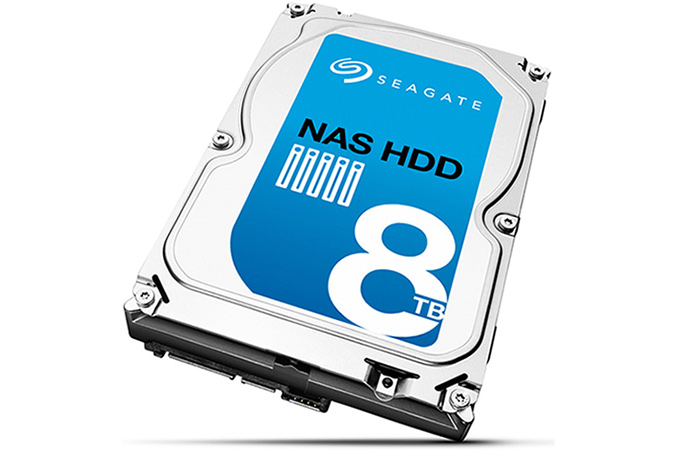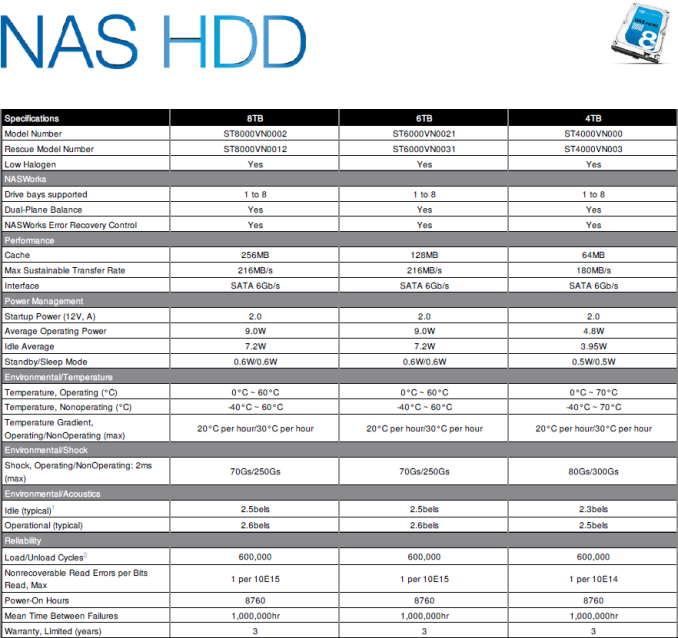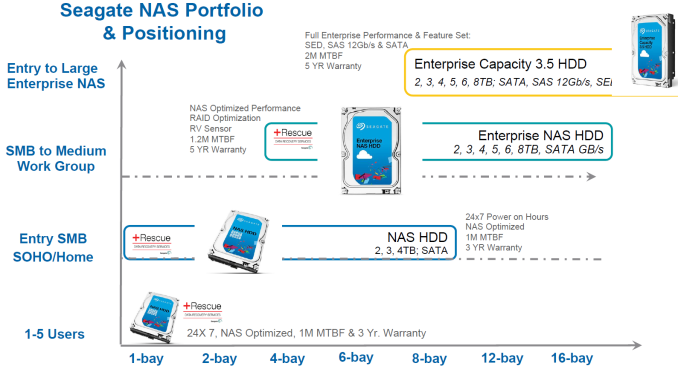Seagate Introduces First 8 TB Hard Disk Drive for Consumer NAS Applications
by Anton Shilov on January 12, 2016 7:05 PM EST
Seagate Technology on Tuesday introduced its new breed of hard disk drives (HDDs) for network area storage (NAS) and RAID applications. The new family of NAS HDDs from Seagate includes a model with 8 TB capacity, which is the industry’s first hard drive of such kind that is targeted towards small and medium businesses as well as personal use, i.e, 1-8 bay NAS units.
Seagate’s 8 TB 3.5-inch NAS HDD is based on six perpendicular magnetic recording (PMR) platters with 1.33 TB capacity each. The hard drive features 7200 revolutions per minute spindle speed, 256 MB DRAM cache as well as a Serial ATA interface. The manufacturer declares 216 MB/s maximum sustainable media to cache transfer rate, which is considerably higher compared to previous-generation drives. The new HDD have average operating power of 9 W as well as average idle power of 7.2 W.
Seagate’s latest family of NAS HDDs also includes models with 6 TB, 4 TB, 3 TB, 2 TB and 1 TB capacities. Hard drives with 6 TB and 8 TB capacities have spindle speed of 7200 RPM, whereas the remaining drives feature 5900 RPM speed.
High-capacity PMR platters, 7200 RPM spindle speed as well as massive 256 MB DRAM cache will help the new 6TB and 8 TB drives to offer very high random read performance, which should be useful not only for NAS environments, but for desktops as well.
Previously Seagate offered 8 TB drives for archive/nearline, enterprise capacity and enterprise NAS applications. Such drives are optimized for servers, racks, maximum reliability, etc., which comes at a price. The new 8 TB HDD for small and medium businesses (SMBs) as well as creative professionals are designed for tower enclosures with one to eight bays and are essentially the first hard drives with such capacity that are optimized for desktop applications. The drives are also fully compatible with select NAS products from companies like ASUSTOR, QNAP, Synology and Thecus.
Hard disk drives for SMB NAS applications use platforms that were developed to handle additional vibration, hence, they are more reliable than desktop-class HDDs, but are less advanced that enterprise-class hard drives. NAS HDDs usually feature dual plane balance control, improved heads as well as special firmware.
Seagate’s NAS HDDs compete against Western Digital’s WD Red lineup. At present, the maximum capacity offered by the WD Red is 6 TB, hence, with 8 TB offerings Seagate will have a competitive advantage over its rival when it comes to NAS hard drives.
The new Seagate NAS HDD 8TB has shipped to select customers. Wide-scale availability is expected at the end of the Q1 2016. Consumers should be on the lookout for the ST8000VN0002 or ST8000VN0012 models, as they are the PMR ones. Seagate also has a ST8000VN000 model which uses host-aware SMR (shingled magnetic recording).The MSRP of the new 8TB PMR NAS HDD from Seagate will be $385 when it ships later this quarter.
Source: Seagate


















38 Comments
View All Comments
khanikun - Wednesday, January 13, 2016 - link
My Seagates were great, but I do feel quality has gone down since they bought Maxtor. Now you will randomly have that 1-2 drive models that every couple years that just suck. So I now tend to wait a few months before purchasing any new type of Seagate. Just to see if there's some issue with it.I'd still rather deal with that than with WD drives (for storage). I find WD drives are better performance, but not as reliable. That's just me though. Others have no issues.
3ogdy - Tuesday, January 12, 2016 - link
Then failure rates get any big at over 40%...which is nearly 1 in every couple drives sold. Once the drive falls, here comes Shitgate to the rescue... saving your data in theirs labs for... you guessed it... only well over $1200. Sea who?3ogdy - Tuesday, January 12, 2016 - link
Corrected: Then failure rates get big at over 40%...which is nearly 1 in every couple drives sold. Once the drive fails, here comes Shitgate to the rescue... saving your data in their labs for... you guessed it... only well over $1200. Sea who?zodiacfml - Tuesday, January 12, 2016 - link
That temperature gradient spec is interesting. Is it possible to go outside that range if I shutdown a desktop while the HDD has a workload? It looks like these are just suitable for NAS use.p1esk - Tuesday, January 12, 2016 - link
Everyone says these Seagate NAS drives have better reliability than "desktop class" drives, but the warranty is just 3 years. Same goes for WD Red models. Yet my WD Black drives have 5 year warranty. What's up with that?etamin - Tuesday, January 12, 2016 - link
I think it just has to do with pricing. The WD Red Pro gets 5 yr warranties. I don't think Seagate offers 5 yrs on any of their NAS drives, but they do on their pricier Constellation and Enterprise lines.It's a shame that literally anectodotal crapping on Seagate is more or less all based on their entry level Barracudas. Well, what do you expect for paying minimum dollar? same can probably be said about WD Blues. And the exclusion of Seagate NAS drives from the Backblaze data most certainly does not help the uninformed and fanboyism.
ABR - Tuesday, January 12, 2016 - link
Is this an article or a press release? And what's "network area storage"?Ian Cutress - Wednesday, January 13, 2016 - link
Like a lot of our pipeline content, it's a dissection of a product announcement based on a press release. The aim is to have lots of information and our analysis therein based on what we understand about the market, not just a copy/paste like others. We've been doing it for over a decade, and it's good to stay on top of announcements to let our readers know if what's announced immediately stands out as having potential or a crock.creed3020 - Wednesday, January 13, 2016 - link
Great explanation Ian, and these articles are one of the reasons I read AT as my primary Tech News source. Its not just a product announcement with a spec sheet.edzieba - Wednesday, January 13, 2016 - link
Note the URE rate for the 6TB and 8TB drives has gone up to 1 in 10E15. That's a good sign, standard consumer 1 in 10E14 would mean a read failure after 100TB, or 13 drive reads. Or put another way, nearly a 10% chance of a read error per drive when rebuilding an array (for anyone foolish enough to still use RAID5, that would be a 1/3 failure chance for a 5-drive array!).